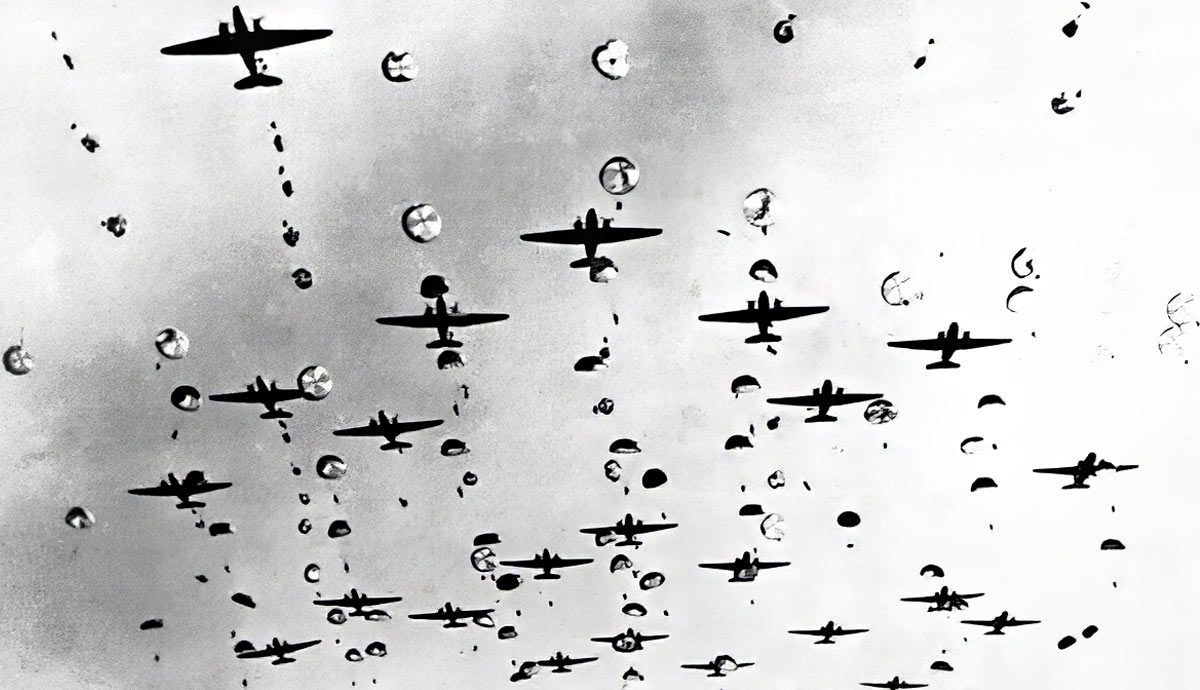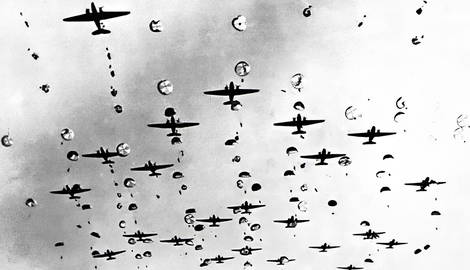
In June 1944, the Allies achieved significant success by landing armies on the shores of Normandy on D-Day. They pushed through the German defenses and created a salient, an outward projection of a line of military attack, into France. With these successes came an overwhelming sense of optimism, and the Allies saw that the end of the war was in sight. Instead of simply consolidating what they had gained, they attempted to speed up the war’s end by creating another front.
Operation Market Garden was conceived to open a front in the Netherlands and create a passage across the Rhine from where the Allies could launch an invasion directly into Germany.
The plan was complex, involving a massive airborne assault involving paratroopers from the UK, the US, and Poland.
The Plan for Operation Market Garden is Drawn Up

While their American allies were advancing rapidly, in part due to the aggressive nature of the American generals, particularly that of General Patton, questions arose as to the abilities of the British and whether they too should adopt more aggressive and risky strategies in defeating the Germans.
The plan for Operation Market Garden was the result of meticulous planning by Field Marshal Bernard Montgomery, who had previously defeated Rommel’s forces in North Africa. Montogmery had a reputation for being a cautious and methodical commander, meaning that Operation Market Garden represented a massive shift in his strategic characteristics.
The objective was to create a 64-mile (103-kilometer) salient from the Netherlands into German territory with a crossing over the Rhine, thus forging a corridor into which the Allies could pour troops directly into the German heartland, and circumvent the northern point of the Siegfried Line, the defensive line which protected the west of Germany.
The operation called for airborne troops who would seize nine bridges across the River Meuse, the Waal River, and the Lower Rhine and create a bridgehead for the follow-up of land forces. They would land at several points between Arnhem in the north and Eindhoven in the south and then push eastwards towards their targets.
The operation was subdivided into two parts, the airborne part designated “Market” and the implementation of land forces designated “Garden.” After the initial landings, the second day would involve Lt-Gen B Horrocks’ XXX Corps of the British Second Army pushing northwards towards Eindhoven from Allied positions in the south.
The Paratroopers Deploy

On September 17, 1944, Operation Market Garden began. Almost 2,000 aircraft, including gliders, dropped elements of the 1st British Airborne Division as well as the 82nd and 101st US Airborne Divisions. The 1st Independent Parachute Brigade from Poland, which was attached to the 1st British Airborne Division, was due to parachute in during the second wave of landings.
The initial landings were successful and on target. Ironically, since the troops weren’t scattered, it may have helped the Germans deduce what the Allied targets actually were.
In the north, The British 1st Airborne Division under the command of General Roy Urquhart encountered difficulties and setbacks as German resistance became more organized, engaging the British and pinning many elements down. The German defenses, assembled from the SS, were effective soldiers and were quick to react, blowing up the British second objective, which was a rail bridge. The 2nd Battalion of the 1st Airborne Division, however, managed to seize their primary objective, the Arnhem Bridge. This was managed despite effective German resistance and the fact that the British radios suffered a system-wide failure, seriously hampering communications.
To the south of Arnhem, the US 82nd Airborne, under the command of Brig. Gen. James M. Gavin, was in action around Nijmegen. With 7,500 troops, they managed to seize the bridge over the Meuse and capture the heights to the southeast of Nijmegen, which would be used as a landing zone for reinforcements. As the Americans launched their assault to capture the bridge north of Nijmegen, however, they were halted by the German 10th SS Panzer Division.

Forty-seven miles south of Nijmegen, the 101st US Airborne Division was experiencing troubles of its own. It had five objectives, of which it promptly seized three. Crucially, however, the objectives it failed to attain were the only two crossings across the same canal. This significantly hampered the progress of the 101st and the XXX Corps, who would have to create crossings of their own if they were to link up with the US 82nd and the British 1st.
To make matters worse, on the first day, a glider containing the Allied plans crashed near German positions, and documents containing the entire Allied operation were discovered by the German defenders.
September 18, Day 2: From Bad to Worse

The second day of the operation started with bad weather, forcing the Allies to delay sending the second wave of paratroopers and supplies. Those already on the ground had to hold out longer.
In Arnhem, the British 2nd battalion was surrounded and running out of ammunition, while to their west, the rest of the 1st Airborne division, pinned down by stiff enemy resistance, was unable to reach Arnhem to relieve their beleaguered 2nd battalion. The rest of the division came under such a heavy assault that it was pushed westwards beyond the original landing zone, and the 1st Independent Polish Parachute Brigade, which was intended to reinforce the attack on Arnhem, was still stuck in England due to the weather. With the landing zone captured, airdropped supplies fell into German hands, and the northern flank of the operation turned into a disaster.
Meanwhile, the 82nd Airborne Division successfully fought off a German counterattack, but the Germans had crossed the Meuse and established defensive positions around Nijmegen.
September 19, Day 3: XXX Corps Engages
By the third day near Eindhoven, the thrust northwards by the XXX Corps encountered the problem of not being able to link up with forces to the north, as the 101st had failed to capture the two vital bridges. A pontoon bridge needed to be constructed, which delayed the advance. Nevertheless, the obstacle was overcome, and the XXX Corps finally managed to continue northwards, where it linked up with the 82nd. The combined Allied force struck the Germans at Nijmegen in order to capture the bridge across the Waal.
Back in Eindhoven, the 101st was locked in combat trying to protect the newly constructed crossing from destruction by the 107th Panzer Division.
September 20, Day 4: the 82nd Airborne & XXX Corps Link Up

On the fourth day, the 1st Airborne Division was completely pinned down and had no hopes of reaching their 2nd battalion stuck in Arnhem. The 2nd battalion held out for hours, furiously holding on to their positions, but the situation was dire and complete defeat seemed inevitable. By the end of the day, however, XXX Corps and the 82nd Airborne had fought their way to the Waal and managed to send troops across the river by boat. They then attacked the Germans from the rear, allowing the rest of the Allied forces in Nijmegen to capture the bridge across the Waal.
This victory would come too late for the 2nd battalion of the 1st Airborne Division. By the fifth day, they were out of ammunition, and with thousands of dead and wounded, the battalion was effectively destroyed, but not before they had inflicted serious casualties upon their enemies.
September 21, Day 5: Disaster for the Polish

The skies over England and the Netherlands finally cleared, allowing the Polish 1st Independent Parachute Brigade to deploy. They opened their parachutes over the town of Driel south of the Lower Rhine and south of the positions of the 1st Airborne Division, which was still pinned down and had lost two-thirds of its manpower.
Upon touchdown, however, the Polish were set upon by withering German fire, and the 1st Independent Parachute Brigade took heavy casualties. The XXX Corps came in range of German positions and provided supporting fire, but it wasn’t nearly enough.
September 22 to 27: Final Defeat
German forces under the command of Colonel Kurt Student, who had commanded the Germans during the invasion of Crete, launched a massive counterattack against the 82nd and XXX Corps south of Nijmegen and prevented them from linking up with the 1st Airborne Division, which by now was on its last legs. Bad weather had hampered the ability to supply the Allied troops throughout the operation, and September 22 was no different.
A temporary truce was declared, and 1,200 British and Polish soldiers laid down their arms. With only 1,700 soldiers of the initial 10,000 left, the 1st Airborne Division was spent. The next order was evacuation, and the British and Polish troops hastily withdrew westwards.
Aftermath of Operation Market Garden: A Bridge Too Far

For the Allies, it seemed everything that could have gone wrong went wrong. The Allies did not have enough aircraft to begin with in order to make one major drop and had to spread out the operation over the course of several days. The weather was a huge factor and limited the resupply and reinforcement of Allied troops on the ground. To add to the chaos, the British radios failed to work, cutting off communications between Urquhart and his men.
Meanwhile, the Germans received excellent intelligence, not only from capturing the Allied plans but from a Dutch double agent who informed the Germans of the Allied plan. Leading the Germans was the highly capable and well-respected Field Marshal Walter Model, and it was under his guidance that the Germans were able to put up such a successful defense and counterattack.
Despite not achieving anything close to what they had hoped for, the Allies had pushed into German territory and created a small but significant salient near Nijmegen, which aided further Allied advances as the strategic operations on the Western Front developed. German counterattacks to dislodge Allied troops from this salient ultimately failed.
As a result of the failure to secure the required bridges, the idiom “a bridge too far” entered the English language and is used to describe a situation of overreaching.

Although widely regarded as a complete failure for the Allied cause, especially since they had hoped to end the war by Christmas 1944, the operation’s failures were a result of overly optimistic expectations. What the Allies did achieve, despite heavy casualties, was still a setback for the Germans and still represented another step towards the final defeat of Germany.










